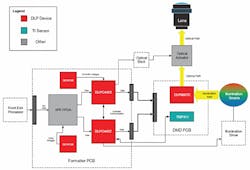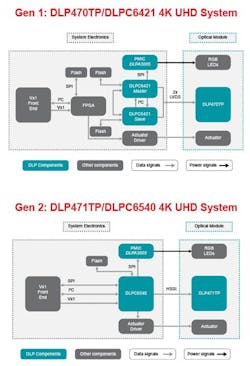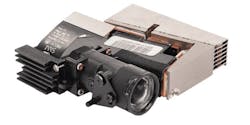DLP® Chipsets Bring Versatility to Applications Requiring 4K UHD Displays
Members can download this article in PDF format.
Just like Goldilocks, the market for display technology knows when something is just right. And when it comes to getting it right, it’s hard to argue against 4K ultra-high-definition (UHD) displays that utilize Texas Instruments’ DLP 4K UHD chipset.
Digital light processing (DLP) technology is a fast-switching microelectromechanical-systems (MEMS) platform that modulates light using a digital micromirror device (DMD) Each of 4.15 million micromirrors has a reflective aluminum surface that can be just a few microns wide. A DMD steers light by electrostatically deflecting or switching each mirror up to thousands of times per second. To make this possible, a 1 or 0 is loaded into a memory cell beneath each mirror, which activates electrodes that control whether the mirror is switch to an on or off state.
An image is created when a DMD is combined with a digital video signal, a light source, and projection optics. The technology can be used with virtually any light source, including lamps, LEDs, and lasers. The DMD is able to steer many types of light, including visible, infrared, and ultraviolet wavelength projection displays to deliver full 4K resolution (8 million pixels for true 3840 × 2160 4K UHD imaging). Put another way, the resolution delivered is equal to combining four 1080p displays.
Two Chipset Families
The TI 4K UHD display chipset brings the performance of DLP Cinema technology to numerous display solutions, including home theater, education and corporate projectors, digital signage, smart lighting, and more.
DLP display technology contains two families of products, DLP Pico chipsets and DLP Standard chipsets. DLP Pico chipsets are a good fit for any application requiring a display with high contrast, small size, and low power. Among the application possibilities are embedded projectors in smartphones and tablets, augmented-reality glasses, battery-powered pico projectors, and mobile smart TVs (Fig. 1).
DLP Standard chipsets enable superb images for systems that require large-screen bright displays with high resolution. Examples include smart-home displays, digital signage, projection mapping signage, business and education displays, and large venue cinemas.
Reduced Component Count
The display system requires two primary connections: power and data. Power must be supplied to the DLP PMIC, and digital video data (including 24-bit RGB, DSI, or Vx1) needs to be supplied to the DLP display controller chip. A media processor, which accepts external sources like HDMI and processes streamed online content, sends digital video data out to the DLP display controller. Alternatively, a product's application processor, such as in a smartphone or tablet, also can send digital video data to the DLP display controller.
Second-generation TI 4K UHD chipsets reduce the number of components required while also adding advanced image-processing capabilities. The portfolio includes the 0.47-in. DLP471TP DMD and DLPC6540 display controller from the DLP Pico family for small designs, while the DLP471TE DMD and DLPC7540 controller from DLP standard chipsets is well-suited for designs above 1,500 lumens (Fig. 2).
Brightness Levels
Brightness requirements are one of the key considerations to account for when designing any projection system. Projector brightness is the amount of visible light emitted from a projector or projection system. It’s measured in ANSI lumens (lm) and is independent of image size. With TI DLP technology, it’s possible to create projectors spanning a broad brightness range: from 30 lumens for projectors embedded into products like smartphones or tablets, to over 10,000 lumens for large venue projectors like the ones used at major sporting events during player introductions or halftime shows.
The DMD, along with its associated electronics, an illumination source, optical elements, and necessary mechanical components, are combined into a compact assembly known as an optical module or light engine. While Texas Instruments designs and supplies DLP chipsets (DMD, controller, and PMIC), system integrators design the electronics and casing and ultimately supply the final product, including the optical module and DLP chipset. Display system performance can vary depending on this optical engine.
Finding the Right Optical Module
Optical-module makers design the optical system and supply the entire optics housing, including the DMD, illumination source, flex cable, and heatsinks (in some cases) (Fig. 3). The products, software, and services listed are produced and managed by independent third parties, not Texas Instruments.
To help best meet your design needs and accelerate your time-to-market, TI works with a variety of third parties to assist with everything from optical modules and hardware design to specialty software and other production services.
Whether you need an off-the-shelf or completely custom solution, TI’s ecosystem partners can help accelerate your design and ramp up to production quantities. You can also download TI’s search tools to browse third-party providers or find a specific optical module:
- The DLP Products third-party provider search tool (DLP-3P-SEARCH) is a list of service providers that can design or manufacture optics, hardware, software, and complementary technologies.
- The DLP Products optical-module search tool (DLP-OMM-SEARCH) is a list of production optical modules with detailed specifications.
TI also offers a 4K UHD display reference design (TIDA-01347) to bring the performance of DLP Cinema technology to applications that require a cost-effective, high-resolution solution for large and bright digital displays. Whether it’s a standalone display system or embedded into an existing design, the company’s reference design and development guides are crafted to accelerate your display innovation efforts.



